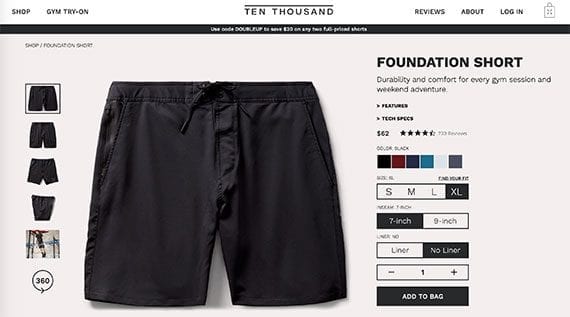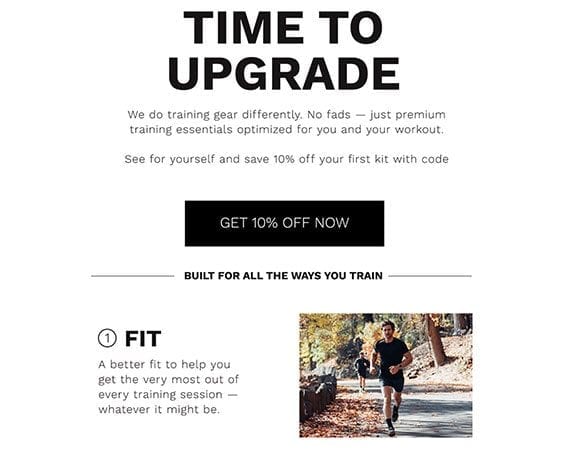Email marketing provides a strong return on investment, requires very little money, and helps even fledgling companies drive sales.
The question, then, for most businesses is not whether they should use email marketing, but how. One strategy is to monitor successful competitors.
Finding Competitors
An online fitness-clothing retailer, as an example, should be able to find successful competitors. A few that come to mind are Nike, Under Armour, Rogue, Gymshark, and Ten Thousand.

Ten Thousand is an example of a successful, well-marketed business in the fitness clothing industry. If your business sold to a similar customer base, you could monitor Ten Thousand’s email marketing, to learn.
Similarly, there are probably five or six high-performing businesses in your industry. Your company can use these competitors as role models for your email marketing.
The competitors may have spent thousands of dollars on email marketing agencies and consumer research. While you cannot read their survey results and study data, you can see how they use email marketing, emulating them when it makes sense.
Subscribe
Make a list of the competitors you want to monitor. Here, again, is a possible list for an online fitness-clothing retailer.
- Nike
- Under Armour
- Rogue
- Gymshark
- Ten Thousand

Like many leading fitness clothing brands, the Under Armour online store emphasizes email marketing and collecting email addresses.
Next, create three email addresses. You might even associate these addresses with different shopper personas. Using different computers, IP addresses, or at least different web browsers, subscribe to each competitor’s mailing list with each of your three email addresses.
If possible, consolidate all of the incoming email marketing messages into a single email client, and filter each competitor’s emails into a separate folder.
The point of three email accounts is that some of these competitors may be using A/B or multivariate testing. While having multiple accounts does not guarantee that you will see each version of an email campaign, it increases your chances of discovering what is being tested.
What follows are five things we can learn from competitors about email marketing.
5 Email Lessons
1. Email automation. The first thing to learn from your competitors’ email marketing is how they treat new subscribers. Are they using email automation for a welcome series? Ten Thousand, as an example, sends a 10-percent-off coupon code with the first message in its welcome series. Could that make sense for your business?

Ten Thousand starts its welcome series with a discount.
Are there other activities that trigger email automation? Explore their sites to learn when and how emails are triggered.
2. Subject lines that sell. Note every subject line you receive from your competitors. Consider putting the subject lines in a spreadsheet, to sort and organize them. Look for patterns that could indicate subject lines that convert and sell well in your industry.
For example, what percentage of subject lines includes a discount offer? Are your competitors using subject lines with questions or powerful statements? Do the subject lines include numbers or lists? Are they short or long? Which ones were the most compelling to you?
Don’t copy subject lines directly, but adapt the ideas to your business. You might develop three subject lines for a campaign based on what you learned from your competitors. Then test those subject lines for the best open rate. Ultimately, you want to create subject line templates to use repeatedly.
3. Body copy. Subject lines will get your audience to open an email, but it is the copy in the body that will convert them. Read through each competitor’s messages and look for patterns.
Do your competitors make an offer quickly? How many words are they using? Is there are single call-to-action or several? How do they differentiate their products?
The first words in the Ten Thousand welcome email focus on differentiating the gear: “We do training gear differently. No fads — just premium training essentials optimized for you and your workout.”
Should your company use a similar approach?
Organize the body copy into groups and use the patterns as ideas for our own email marketing messages. Again, adapt — don’t copy.
4. High converting offers. After 18 months of testing, a brick-and-click retailer in the northwestern United States found that, for its subscribers, $10 off of a $50 purchase was the best performing offer. The company now uses that offer regularly.
The “$10 off of $50” was included in email marketing, as well as direct (physical) mail and even display advertising. Not surprisingly, three of the company’s competitors caught on, and now all of these companies offer $10 off of $50 coupons and codes.
As you collect email messages from your model competitors, pay attention to what offers they are making and when they are making them. Do they offer deep discounts of 40-or-50 percent or is 10 percent more common? Are offers made around shopping holidays? Do the offers tend to come at a certain time of the month?
Look for trends that could indicate a strategy. Then apply what you learn to your own email marketing offers.
5. Frequency. Finally, track how often your competitors send email messages. If could be a lot more frequent than you think. Some successful online retailers send five or more email marketing messages every week. Is that the case for your competitors?
Also, note the days of the week and the time of day. Do your competitors tend to send messages in the morning or evening? Are there more emails at the beginning or end of a week?
As with everything on this list, adapt these trends and patterns to your own email marketing. Test open, click, and conversion rates as you go.